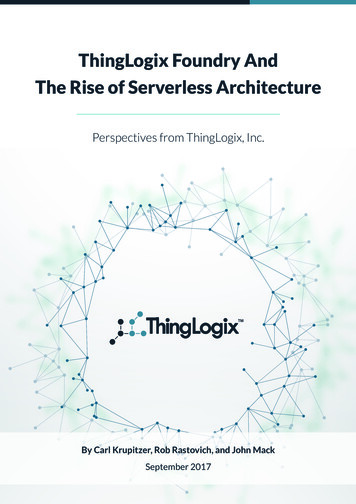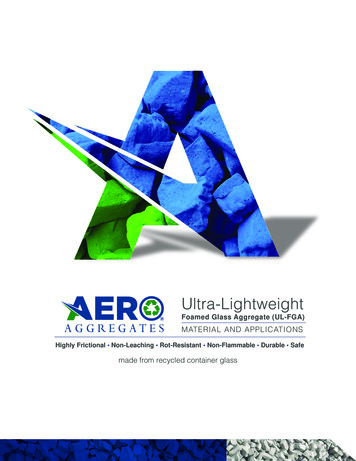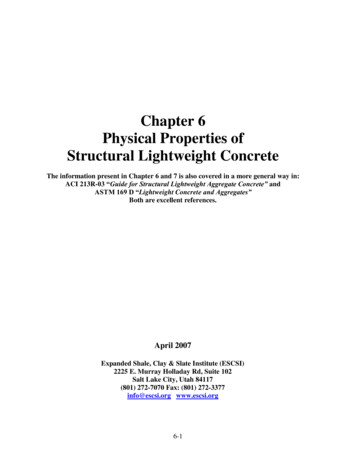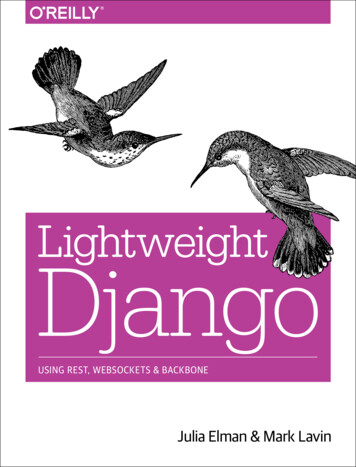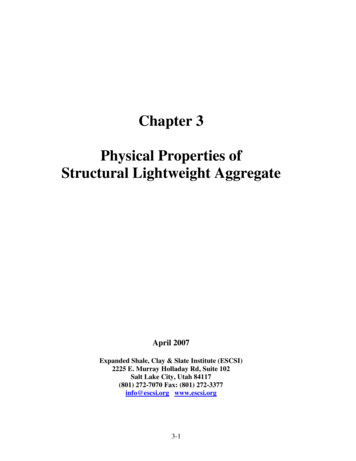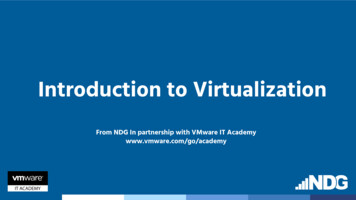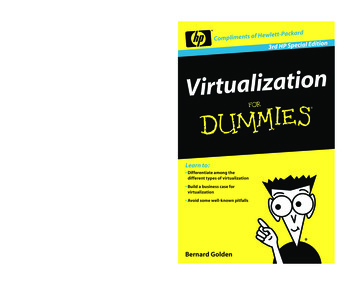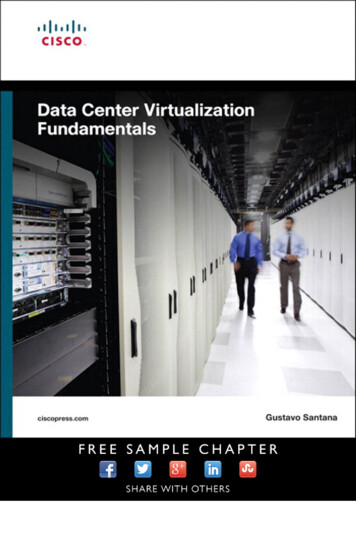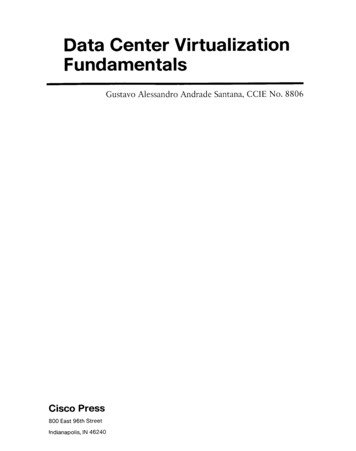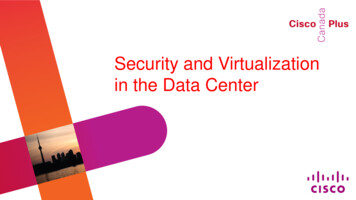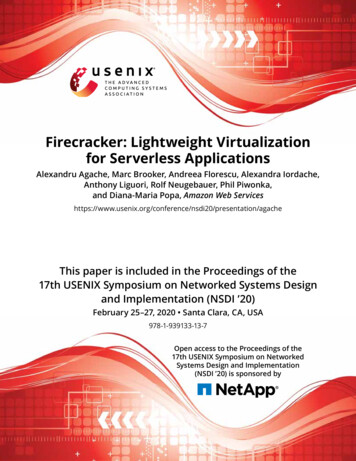
Transcription
Firecracker: Lightweight Virtualizationfor Serverless ApplicationsAlexandru Agache, Marc Brooker, Andreea Florescu, Alexandra Iordache,Anthony Liguori, Rolf Neugebauer, Phil Piwonka,and Diana-Maria Popa, Amazon Web resentation/agacheThis paper is included in the Proceedings of the17th USENIX Symposium on Networked Systems Designand Implementation (NSDI ’20)February 25–27, 2020 Santa Clara, CA, USA978-1-939133-13-7Open access to the Proceedings of the17th USENIX Symposium on NetworkedSystems Design and Implementation(NSDI ’20) is sponsored by
Firecracker: Lightweight Virtualization for Serverless ApplicationsAlexandru AgacheAmazon Web ServicesMarc BrookerAmazon Web ServicesAndreea FlorescuAmazon Web ServicesAlexandra IordacheAmazon Web ServicesAnthony LiguoriAmazon Web ServicesRolf NeugebauerAmazon Web ServicesPhil PiwonkaAmazon Web ServicesAbstractServerless containers and functions are widely used for deploying and managing software in the cloud. Their popularityis due to reduced cost of operations, improved utilization ofhardware, and faster scaling than traditional deployment methods. The economics and scale of serverless applications demand that workloads from multiple customers run on the samehardware with minimal overhead, while preserving strong security and performance isolation. The traditional view is thatthere is a choice between virtualization with strong securityand high overhead, and container technologies with weaker security and minimal overhead. This tradeoff is unacceptable topublic infrastructure providers, who need both strong securityand minimal overhead. To meet this need, we developed Firecracker, a new open source Virtual Machine Monitor (VMM)specialized for serverless workloads, but generally useful forcontainers, functions and other compute workloads within areasonable set of constraints. We have deployed Firecracker intwo publically-available serverless compute services at Amazon Web Services (Lambda and Fargate), where it supportsmillions of production workloads, and trillions of requestsper month. We describe how specializing for serverless informed the design of Firecracker, and what we learned fromseamlessly migrating Lambda customers to Firecracker.1IntroductionServerless computing is an increasingly popular model fordeploying and managing software and services, both in publiccloud environments, e.g., [4, 16, 50, 51], as well as in onpremises environments, e.g., [11, 41]. The serverless modelis attractive for several reasons, including reduced work inoperating servers and managing capacity, automatic scaling,pay-for-use pricing, and integrations with sources of eventsand streaming data. Containers, most commonly embodiedby Docker, have become popular for similar reasons, including reduced operational overhead, and improved manageability. Containers and Serverless offer a distinct economic ad-USENIX AssociationDiana-Maria PopaAmazon Web Servicesvantage over traditional server provisioning processes: multitenancy allows servers to be shared across a large number of workloads, and the ability to provision new functions and containers in milliseconds allows capacity to beswitched between workloads quickly as demand changes.Serverless is also attracting the attention of the research community [21,26,27,44,47], including work on scaling out videoencoding [13], linear algebra [20, 53] and parallel compilation [12].Multitenancy, despite its economic opportunities, presentssignificant challenges in isolating workloads from one another.Workloads must be isolated both for security (so one workloadcannot access, or infer, data belonging to another workload),and for operational concerns (so the noisy neighbor effectof one workload cannot cause other workloads to run moreslowly). Cloud instance providers (such as AWS EC2) facesimilar challenges, and have solved them using hypervisorbased virtualization (such as with QEMU/KVM [7, 29] orXen [5]), or by avoiding multi-tenancy and offering baremetal instances. Serverless and container models allow manymore workloads to be run on a single machine than traditionalinstance models, which amplifies the economic advantages ofmulti-tenancy, but also multiplies any overhead required forisolation.Typical container deployments on Linux, such as thoseusing Docker and LXC, address this density challenge byrelying on isolation mechanisms built into the Linux kernel.These mechanisms include control groups (cgroups), whichprovide process grouping, resource throttling and accounting;namespaces, which separate Linux kernel resources such asprocess IDs (PIDs) into namespaces; and seccomp-bpf, whichcontrols access to syscalls. Together, these tools provide apowerful toolkit for isolating containers, but their reliance ona single operating system kernel means that there is a fundamental tradeoff between security and code compatibility.Container implementors can choose to improve security bylimiting syscalls, at the cost of breaking code which requiresthe restricted calls. This introduces difficult tradeoffs: implementors of serverless and container services can choose17th USENIX Symposium on Networked Systems Design and Implementation419
between hypervisor-based virtualization (and the potentiallyunacceptable overhead related to it), and Linux containers(and the related compatibility vs. security tradeoffs). We builtFirecracker because we didn’t want to choose.Other projects, such as Kata Containers [14], Intel’s ClearContainers, and NEC’s LightVM [38] have started from asimilar place, recognizing the need for improved isolation,and choosing hypervisor-based virtualization as the way toachieve that. QEMU/KVM has been the base for the majorityof these projects (such as Kata Containers), but others (suchas LightVM) have been based on slimming down Xen. WhileQEMU has been a successful base for these projects, it is alarge project ( 1.4 million LOC as of QEMU 4.2), and hasfocused on flexibility and feature completeness rather thanoverhead, security, or fast startup.With Firecracker, we chose to keep KVM, but entirely replace QEMU to build a new Virtual Machine Monitor (VMM),device model, and API for managing and configuring MicroVMs. Firecracker, along with KVM, provides a new foundation for implementing isolation between containers andfunctions. With the provided minimal Linux guest kernel configuration, it offers memory overhead of less than 5MB percontainer, boots to application code in less than 125ms, andallows creation of up to 150 MicroVMs per second per host.We released Firecracker as open source software in December20181 , under the Apache 2 license. Firecracker has been usedin production in Lambda since 2018, where it powers millionsof workloads and trillions of requests per month.Section 2 explores the choice of an isolation solution forLambda and Fargate, comparing containers, language VMisolation, and virtualization. Section 3 presents the design ofFirecracker. Section 4 places it in context in Lambda, explaining how it is integrated, and the role it plays in the performance and economics of that service. Section 5 comparesFirecracker to alternative technologies on performance, density and overhead.1.1SpecializationFirecracker was built specifically for serverless and containerapplications. While it is broadly useful, and we are excited tosee Firecracker be adopted in other areas, the performance,density, and isolation goals of Firecracker were set by its intended use for serverless and containers. Developing a VMMfor a clear set of goals, and where we could make assumptionsabout the properties and requirements of guests, was significantly easier than developing one suitable for all uses. Thesesimplifying assumptions are reflected in Firecracker’s designand implementation. This paper describes Firecracker in context, as used in AWS Lambda, to illustrate why we made thedecisions we did, and where we diverged from existing VMMdesigns. The specifics of how Firecracker is used in Lambdaare covered in Section 4.1.1 er is probably most notable for what it does not offer, especially compared to QEMU. It does not offer a BIOS,cannot boot arbitrary kernels, does not emulate legacy devices nor PCI, and does not support VM migration. Firecracker could not boot Microsoft Windows without significantchanges to Firecracker. Firecracker’s process-per-VM modelalso means that it doesn’t offer VM orchestration, packaging,management or other features — it replaces QEMU, ratherthan Docker or Kubernetes, in the container stack. Simplicity and minimalism were explicit goals in our developmentprocess. Higher-level features like orchestration and metadatamanagement are provided by existing open source solutionslike Kubernetes, Docker and containerd, or by our proprietary implementations inside AWS services. Lower-level features, such as additional devices (USB, PCI, sound, video,etc), BIOS, and CPU instruction emulation are simply not implemented because they are not needed by typical serverlesscontainer and function workloads.2Choosing an Isolation SolutionWhen we first built AWS Lambda, we chose to use Linuxcontainers to isolate functions, and virtualization to isolatebetween customer accounts. In other words, multiple functions for the same customer would run inside a single VM,but workloads for different customers always run in differentVMs. We were unsatisfied with this approach for several reasons, including the necessity of trading off between securityand compatibility that containers represent, and the difficultiesof efficiently packing workloads onto fixed-size VMs. Whenchoosing a replacement, we were looking for something thatprovided strong security against a broad range of attacks (including microarchitectural side-channel attacks), the abilityto run at high densities with little overhead or waste, and compatibility with a broad range of unmodified software (Lambdafunctions are allowed to contain arbitrary Linux binaries, anda significant portion do). In response to these challenges, weevaluated various options for re-designing Lambda’s isolationmodel, identifying the properties of our ideal solution:Isolation: It must be safe for multiple functions to run on thesame hardware, protected against privilege escalation,information disclosure, covert channels, and other risks.Overhead and Density: It must be possible to run thousands of functions on a single machine, with minimalwaste.Performance: Functions must perform similarly to runningnatively. Performance must also be consistent, and isolated from the behavior of neighbors on the same hardware.Compatibility: Lambda allows functions to contain arbitrary Linux binaries and libraries. These must be supported without code changes or recompilation.17th USENIX Symposium on Networked Systems Design and ImplementationUSENIX Association
Fast Switching: It must be possible to start new functionsand clean up old functions quickly.Soft Allocation: It must be possible to over commit CPU,memory and other resources, with each function consuming only the resources it needs, not the resources it isentitled to.Untrusted CodeGuest KernelUntrusted CodeHost KernelSome of these qualities can be converted into quantitativegoals, while others (like isolation) remain stubbornly qualitative. Modern commodity servers contain up to 1TB of RAM,while Lambda functions use as little as 128MB, requiringup to 8000 functions on a server to fill the RAM (or moredue to soft allocation). We think of overhead as a percentage,based on the size of the function, and initially targeted 10% onRAM and CPU. For a 1024MB function, this means 102MBof memory overhead. Performance is somewhat complex, asit is measured against the function’s entitlement. In Lambda,CPU, network, and storage throughput is allocated to functions proportionally to their configured memory limit. Withinthese limits, functions should perform similarly to bare metalon raw CPU, IO throughput, IO latency and other metrics.2.1Evaluating the Isolation OptionsBroadly, the options for isolating workloads on Linux can bebroken into three categories: containers, in which all workloads share a kernel and some combination of kernel mechanisms are used to isolate them; virtualization, in which workloads run in their own VMs under a hypervisor; and languageVM isolation, in which the language VM is responsible for either isolating workloads from each other or from the operatingsystem. 2Figure 1 compares the security approaches between Linuxcontainers and virtualization. In Linux containers, untrustedcode calls the host kernel directly, possibly with the kernelsurface area restricted (such as with seccomp-bpf). It alsointeracts directly with other services provided by the hostkernel, like filesystems and the page cache. In virtualization,untrusted code is generally allowed full access to a guestkernel, allowing all kernel features to be used, but explicitlytreating the guest kernel as untrusted. Hardware virtualizationand the VMM limit the guest kernel’s access to the privilegeddomain and host kernel.2.1.1Linux ContainersContainers on Linux combine multiple Linux kernel featuresto offer operational and security isolation. These features include: cgroups, providing CPU, memory and other resource2 It’s somewhat confusing that in common usage containers is both used todescribe the mechanism for packaging code, and the typical implementationof that mechanism. Containers (the abstraction) can be provided withoutdepending on containers (the implementation). In this paper, we use the termLinux containers to describe the implementation, while being aware thatother operating systems provide similar functionality.USENIX AssociationVMMsandbox(a) Linux container modelsandboxKVMHost Kernel(b) KVM virtualization modelFigure 1: The security model of Linux containers (a) dependsdirectly on the kernel’s sandboxing capabilities,
This paper is include in the roceedings of the 17th SENI Symposiu on etworke Systes esign and plementation NSDI 20) Feruar 5–27 02 Santa lara A SA 978-1-93913-1-7 Open access to the roceedings of the 17th SENIX Syposium on etworked Systems esign an mplementation (NSD 20 is sponsore y Firecracker: Lightweight Virtualization for Serverless Applications Alexandru Agache, Marc
